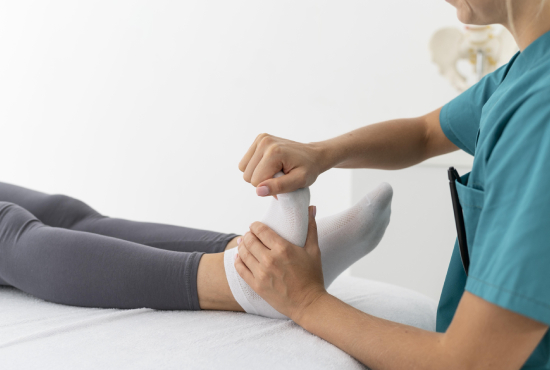Introduction to Ankle Pain Physiotherapy
Expert Physiotherapy for Comprehensive Ankle Care
Ankle pain, whether from sprains, injuries, or chronic conditions, can significantly limit mobility and quality of life. At Orthocure, we offer specialized physiotherapy tailored to effectively diagnose and treat a wide range of ankle issues. Our experienced physiotherapists use advanced techniques to reduce pain, enhance healing, and restore function. Whether you are dealing with an ankle sprain, ligament damage, or post-surgical recovery, our goal is to provide personalized care that targets the root causes of your ankle pain and promotes a speedy recovery.

Understanding Ankle Pain Challenges
Addressing the Complexities of Ankle Injuries and Conditions
Ankle pain arises from various sources, each requiring specific physiotherapeutic approaches
These are common in athletes, requiring immediate and ongoing physio to prevent long-term damage.
Such as tendonitis and arthritis, benefit from regular physiotherapy to manage pain and mobility.
Need specialized interventions to promote healing and prevent recurrence.
Post-operative care ensures successful rehabilitation and full functional recovery.

Benefits of Physiotherapy for Ankle Pain
Transformative Benefits of Physiotherapy for Ankle Conditions
Physiotherapy provides numerous advantages for individuals suffering from ankle pain
Enhanced Mobility and Stability
Through targeted exercises that strengthen the ankle and improve balance.
Practical Pain Management
Manual therapy and modalities like ultrasound or electrical stimulation.
Injury Prevention
Education on proper techniques and exercises helps reduce the risk of future injuries.
Accelerated Healing
Custom rehabilitation plans designed to speed up recovery after injuries or surgeries.
Types of Ankle Conditions Treated
Comprehensive Treatment for Ankle and Foot Conditions

Our physiotherapy treatments cover a broad spectrum of ankle and foot conditions
Ankle Sprains and Strains
Focused on reducing inflammation and restoring movement.
Ligament Injuries
Techniques to rebuild strength and flexibility in the ankle ligaments.
Tendonitis and Overuse Injuries
Management includes stretching, strengthening, and sometimes orthotic recommendations.
Post-Surgical Rehabilitation
Ensures a safe return to activity with optimal outcomes.
The Orthocure Approach to Ankle Pain Physiotherapy
Our Strategic Approach to Ankle Rehabilitation
Initial Assessment and Diagnosis
Detailed evaluations are performed to pinpoint specific ankle or foot issues.
Personalized Treatment Plans
Tailored to address individual symptoms and recovery goals.
Integrated Therapeutic Techniques
Combines hands-on treatment with therapeutic exercises.
Preventative Strategies and Patient Education
This program focuses on teaching patients how to maintain ankle health and prevent future issues.
FAQs on Ankle Pain Physiotherapy
Physiotherapy for ankle pain typically includes manual therapy, targeted exercises, and sometimes modalities like ultrasound or electrical stimulation. The treatment aims to reduce pain, improve mobility, and strengthen the muscles around the ankle to prevent future injuries. Treatment starts with assessing the ankle’s condition, followed by a customized therapy plan that addresses specific needs, such as reducing swelling, restoring range of motion, and enhancing overall foot and ankle function.
Physiotherapy is crucial for recovering from a sprained ankle, as it helps to restore strength, flexibility, and stability to the affected area. Treatment may include exercises to improve balance and coordination, manual therapy to reduce pain and swelling, and specific techniques to promote tissue healing. By following a structured physiotherapy regimen, patients can expect a quicker return to activities and a reduced risk of re-injury. It also focuses on preventative strategies to strengthen the ankle and improve proprioception.
After ankle ligament damage, physiotherapy helps rebuild strength, restore functionality, and reduce the likelihood of chronic ankle instability. The therapy sessions involve exercises that strengthen the ankle and improve balance, manual therapy to enhance joint mobility, and education on ankle protection strategies. Effective physiotherapy can significantly decrease recovery time, facilitate a safer return to sports or daily activities, and minimize the risk of future ankle problems.
Yes, physiotherapy is highly effective in treating chronic ankle pain. It addresses both the symptoms and underlying causes of the pain through a variety of techniques. These include strengthening and flexibility exercises, joint mobilization, and advice on footwear or orthotics. For patients with persistent ankle pain, physiotherapy offers a pathway to improve their quality of life by enhancing physical function and reducing pain levels long-term.
During your first physiotherapy session for an ankle injury, expect a thorough assessment of your ankle, including a review of your injury history, a physical examination, and possibly some functional tests to determine the extent of the injury. The physiotherapist will discuss your treatment goals and develop a personalized treatment plan that may start with gentle exercises to reduce pain and swelling. They will also provide information on managing your injury at home and the expected timeline for recovery.
Physiotherapy is highly effective for rehabilitation after foot and ankle surgery. It is critical in helping patients regain strength, flexibility, and functionality. The therapy typically includes exercises to improve range of motion, strengthening exercises to support the repaired structures, and modalities to reduce pain and swelling. By adhering to a tailored physiotherapy program, patients can enhance their recovery process and reduce the likelihood of complications or long-term mobility issues.
Recovery times from an ankle sprain can vary greatly depending on the severity of the sprain and the individual’s response to treatment. With physiotherapy, mild sprains may heal within a few weeks, while more severe sprains might take several months. Physiotherapy accelerates this process by improving circulation, reducing swelling, and strengthening the ankle’s supporting muscles. Regular sessions and adherence to prescribed home exercises are crucial for adequate recovery, and therapists often adjust the treatment plan based on the patient’s progress.
Physiotherapy for ankle rehabilitation typically consists of exercises designed to restore mobility, strengthen the ankle, and improve balance. These exercises consist of ankle dorsiflexion, plantarflexion, towel curls, heel raises, and various forms of stretching and strengthening using resistance bands. Balance exercises such as standing on one foot or using a balance board are also expected to help restore the ankle’s proprioceptive abilities, which are crucial for preventing future sprains.
Physiotherapy is crucial in managing ankle ligament injuries by helping to restore strength, flexibility, and function to the injured ankle. The initial focus is on reducing pain and swelling through ice therapy and soft tissue massage. As healing progresses, the treatment shifts towards restoring range of motion and gradually reintroducing weight-bearing activities. Strengthening exercises are essential for rebuilding the ankle’s stability, and education on proper techniques helps prevent future injuries.
While physiotherapy cannot “cure” chronic ankle instability, it is highly effective in managing symptoms and improving ankle function. Treatment focuses on strengthening the muscles around the ankle, improving balance, and enhancing proprioceptive feedback, which help stabilize the ankle together. Patients often experience significant improvements in their ability to perform daily activities without recurring injuries. Continuous, tailored exercise regimens are crucial to managing the condition long-term.
For ankle pain stemming from tendonitis, physiotherapists typically use a combination of manual therapy techniques, such as massage and mobilization, to reduce inflammation and relieve pain. They also prescribe specific exercises that stretch and strengthen the affected tendon, helping it heal and preventing future issues. Additionally, therapists may utilize ultrasound or laser therapy to enhance tissue repair and reduce pain.
After an ankle fracture, physiotherapy helps restore function and strength to the injured ankle once the bone has healed. The physiotherapist will initially focus on reducing stiffness and improving mobility through range-of-motion exercises, followed by strengthening exercises to rebuild muscle mass and support around the ankle. Treatment also includes gait training and balance exercises to ensure safe and effective movement patterns, facilitating a return to normal activities.
Yes, physiotherapy treatments for ankle pain can be highly customized for athletes to meet the specific demands of their sports. Therapy for athletes not only focuses on rapid pain relief and recovery but also on conditioning and strengthening programs that align with their sport-specific needs. This ensures that athletes can return to their sport competitively, with a reduced risk of re-injury.
Physiotherapy offers several preventive measures for recurring foot and ankle injuries, including strengthening and flexibility exercises, proprioceptive training, and education on proper footwear and sports techniques. Preventive physiotherapy focuses on improving overall foot and ankle resilience, ensuring that muscles and ligaments can withstand the stresses of daily activities and sports. Regular physiotherapy sessions help maintain optimal ankle health and prevent the frequency and severity of injuries.

